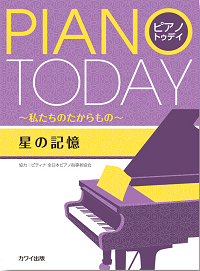Abe, Miho : ちからもちショベルカー
Work Overview
Genre:Various works
Commentary (2)
Author : Ooi, Kazurou
Last Updated: May 14, 2024
[Open]
Author : Ooi, Kazurou
This piece, with its optimistic mood and humorous elements, is intended to be played joyfully. Consequently, the staccato should not be heavy, aiming for a light and smooth flow. The primary challenge, however, lies in the scales, specifically ensuring their smooth execution.
In measures 1 and 3, when the left hand begins and passes the baton to the right hand, the choice of which finger the left hand starts with makes a difference, but a particular point of caution concerns the use of finger 1. For example, if the left hand starts with finger 4 in measure 3, the C on the third beat will be played with finger 1. Finger 1 is the strongest among the five fingers, and if it plays the last note of a passage, an undue accent may be produced, leading to unevenness in the scale. Please be careful.
In measure 9, the left hand's passage from the off-beat of beat 3 to beat 4 is a hand-off from the right hand. As playing B with finger 1 proves exceptionally difficult, if B is taken with finger 2, B-A-G will be played with fingers 2-3-4, and the evenness of these notes is paramount. Should evenness remain elusive, it is also possible for the right hand to play up to B, and the left hand to play A and G with fingers 1-2. Please experiment with similar adaptations in subsequent passages.
Author : Kumamoto, Ryohei
Last Updated: January 16, 2025
[Open]
Author : Kumamoto, Ryohei
Form
It is in binary form.
- A [a (measures 1-4) + b (measures 5-8)]
- B [c (theme inversion development) (measures 9-12) + d (coda) (measures 13-17)]
Musical Analysis
The main key is F major. The theme is found in measures 1-2. The motif consists of a simple ascending scale progression, two staccato quarter notes with a somewhat angular motion, and a half note with a tenuto. This likely represents the movements of the excavator, which is the title of the piece.
From measures 1 to 4, this two-measure theme is repeated, changing its key from F major to G major. Not only does the pitch change, but the change in key significantly alters the color and brightness of the music.
In measures 5 to 8, the modulation shifts from F major to C major. Such a rapid succession of modulations is uncommon in music, making this piece suitable for educational purposes, such as comparing tonalities.
The middle section, being a development of the theme in inversion, begins with a descending scalar motif. It would be enjoyable to consider how to vary the expression compared to the ascending form of the theme.
The d-coda section is somewhat extended because the cadence is prolonged by inserting the movement in measure 16. From measures 13 to 15, just as the piece seems to be approaching its end, the placement of the F-sharp creates a sense of surprise. The piece concludes with a strong perfect authentic cadence, moving from a perfect consonant interval of a fifth to an octave.






